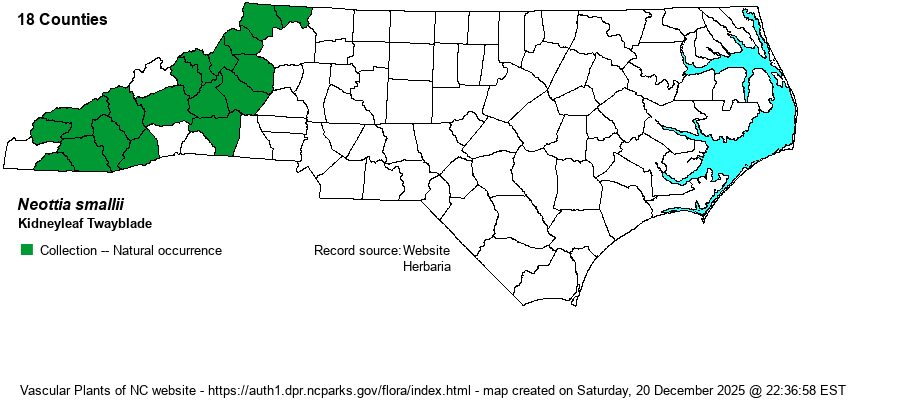| Author | (Wiegand) Szlatchetko | |
| Distribution | Occurs throughout the Mountains, and possibly in the higher foothills of the Piedmont; however, it is absent east of there.
Endemic to the Appalachian Mountains from PA to SC and GA. | |
| Abundance | Uncommon to fairly common, essentially over its range in the Mountains; however, owing to its small size and colors that blend in with dead leaves and soil, it is easily overlooked. Presumably occurs in all Mountain counties. | |
| Habitat | This species prefers cool, moist to damp (but not truly wet) shaded habitats. It favors lower montane forested slopes under Rosebay Rhododendron (Rhododendron maximum), but also occurs in shaded boggy ground and very damp slopes. | |
| Phenology | Blooms in June and July, and fruits shortly after flowering. | |
| Identification | As with the other two Listera species, this is a very small orchid that is easily overlooked. It has a slender, brown to purple stem growing only to about 6-8 inches at best, with a pair of green leaves that are rounded to kidney-shaped (and up to 1 inch long) about halfway up the stem. The top portion of the stem contains the roughly 10-12 flowers. These are about 1/2-inch long, mostly dull purple, with a broad, flat lip that has two rounded lobes (rather than long and spike-like lobes found in N. bifolia and N. cordata). This is the most numerous of the three twayblades (Neottia) in the state, and an active observer in the mountains can run across it somewhat regularly if working in habitats containing much Rosebay Rhododendron. | |
| Taxonomic Comments | Some references use the genus Neottia instead of Listera. Thus, their name for this species is Neottia smallii.
| |
| Other Common Name(s) | Appalachian Twayblade, Small's Twayblade | |
| State Rank | S4 [S3] | |
| Global Rank | G4 | |
| State Status | | |
| US Status | | |
| USACE-agcp | | |
| USACE-emp | FACW link |

